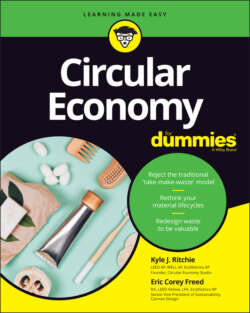Читать книгу Circular Economy For Dummies - Eric Corey Freed - Страница 62
Redefining risk and liability
ОглавлениеWhen it comes to business, risk is defined as any exposure the company might have that would affect its ability to make profits or cause it to fail. Risk is anything that threatens a company’s ability to meet its financial goals. Large companies often have entire departments dedicated to identifying, reducing, and mitigating the various risks that threaten the company’s bottom line.
The linear take-make-waste economy represents a significant amount of business risk that often goes unaccounted for. Here are some common risks found in the linear economy (which the circular economy can reduce or eliminate):
Single-source supply chains are risky if your company is dependent on just that one supplier. A disruption threatens the entire product line.
The price volatility and supply chain disruptions of resource-intensive materials risks your company’s ability to deliver your products.
The unpredictable and fluctuating costs of fossil fuels threatens your company’s ability to set pricing, which affects profitability.
The growing threat of climate change is driving adoption of a carbon tax on emissions, which would force your company to address its carbon footprint.
The unpredictable and more severe weather patterns caused by climate change are threatening to disrupt your operations, driving the need for redundant systems and resiliency planning.
The ever-increasing frequency of hurricanes, wildfires, and floods threatens to leave some of your company assets stranded, further driving the need for change.
As more and more companies begin to address their liability in terms of waste, carbon, and material sourcing, many of these risks will become more apparent and better managed. All this will only drive further adoption of a circular approach.
In addition, the circular economy offers certain risk reduction advantages over the linear economy, including these:
Having a more robust and sustainable supply chain reduces the risky side effects of your business (pollution, waste, damage) that normally would be ignored in a linear economy model.
By reusing, reselling, and recovering your products, your company can significantly reduce its material costs; using longer lasting materials also reduces customer returns while still under warranty.
Having your customers return your products to you at the end of the product's useful life also improves the quality of your customer interaction and boosts customer loyalty.
A product that’s designed to be repaired or upgraded easily also reduces product complexity and the chance of things going wrong. With the right design, a broken item can be cheaply repaired or replaced with fewer product losses.
